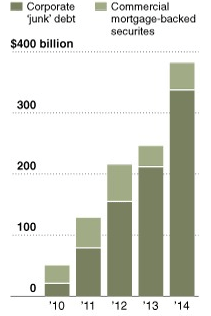According to the NYTimes, $700 billion in high-yeild corporates mature from 2012 to 2014:
.
.
.
.
.
.
.
.
.
.
.
More from the Times article:
With huge bills about to hit corporations and the federal government around the same time, the worry is that some companies will have trouble getting new loans, spurring defaults and a wave of bankruptcies.
The United States government alone will need to borrow nearly $2 trillion in 2012, to bridge the projected budget deficit for that year and to refinance existing debt.
Indeed, worries about the growth of national, or sovereign, debt prompted Moody’s Investors Service to warn on Monday that the United States and other Western nations were moving “substantially” closer to losing their top-notch Aaa credit ratings…
Sovereign debt aside, the approaching scramble for corporate financing could strain the broader economy as jobs are cut, consumer spending is scaled back and credit is tightened for both consumers and businesses.
Private equity firms and many nonfinancial companies were able to borrow on easy terms until the credit crisis hit in 2007, but not until 2012 does the long-delayed reckoning begin for a series of leveraged buyouts and other deals that preceded the crisis.
That is because the record number of bonds and loans that were issued to finance those transactions typically come due in five to seven years, said Diane Vazza, head of global fixed-income research at Standard & Poor’s.
In addition, she said, many companies whose debt matured in 2009 and 2010 have been able to extend their loans, but the extra breathing room is only adding to the bill for 2012 and after.
The result is a potential financial doomsday, or what bond analysts call a maturity wall. From $21 billion due this year, junk bonds are set to mature at a rate of $155 billion in 2012, $212 billion in 2013 and $338 billion in 2014.
The credit markets have gradually returned to normal since the financial crisis, particularly in recent months, making more loans available to companies and signaling confidence in the pace of economic recovery. But the issue is whether they can absorb the coming surge in demand for credit.
“Returned to normal” apparently means lending money to people who can’t pay it back. And of course junk bonds are just part of the debt load:
TheTreasury Department estimates that the federal budget deficit in 2012 will total $974 billion, down from this year’s $1.8 trillion, but still huge by historical standards.
Next in line are companies with investment-grade credit ratings. They must refinance $1.2 trillion in loans between 2012 and 2014, including $526 billion in 2012. Finally, there is the looming rollover of commercial mortgage-backed securities, which will double in the next three years, hitting $59.7 billion in 2012.
Even if most of the debt does get refinanced, companies may have to pay more, if heavy government borrowing causes rates for all borrowers to rise.
“These are huge numbers,” said Tom Atteberry, who manages $5.6 billion in bonds for First Pacific Advisors, and is particularly alarmed by Washington’s borrowing. “Other players will get crowded out or have to pay significantly more, because the government is borrowing so much.”
Most critics of deficit spending have focused on the budget gap alone, but Washington will actually have to borrow $1.8 trillion in 2012, because $859 billion in old bonds will come due and have to be refinanced in addition to the deficit. By 2013 and 2014, $1.4 trillion will have to be raised annually.
In the late 1990s, the federal government ran a surplus and actually paid down a small portion of the national debt. But with the huge deficits of the last few years, the national debt has grown to more than $12 trillion.
All this debt is simply unpayable, and soon unserviceable. There is no solution but default. When the government bumps up against the limits of its credit, that will be the coup de grace.

